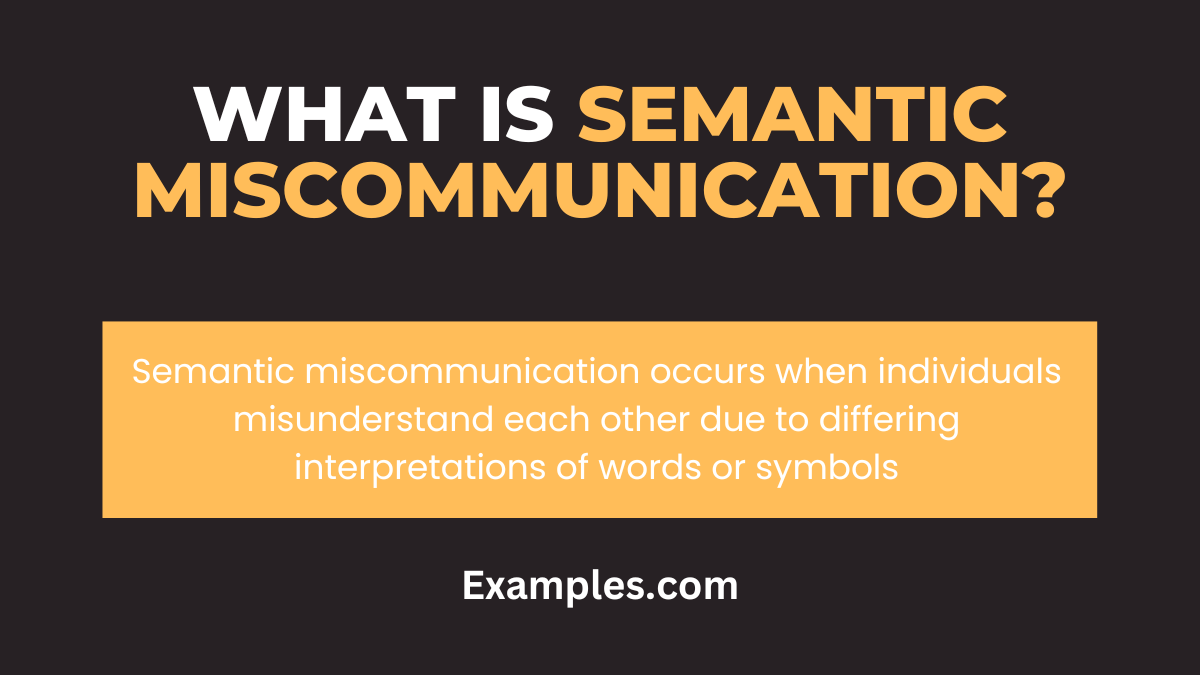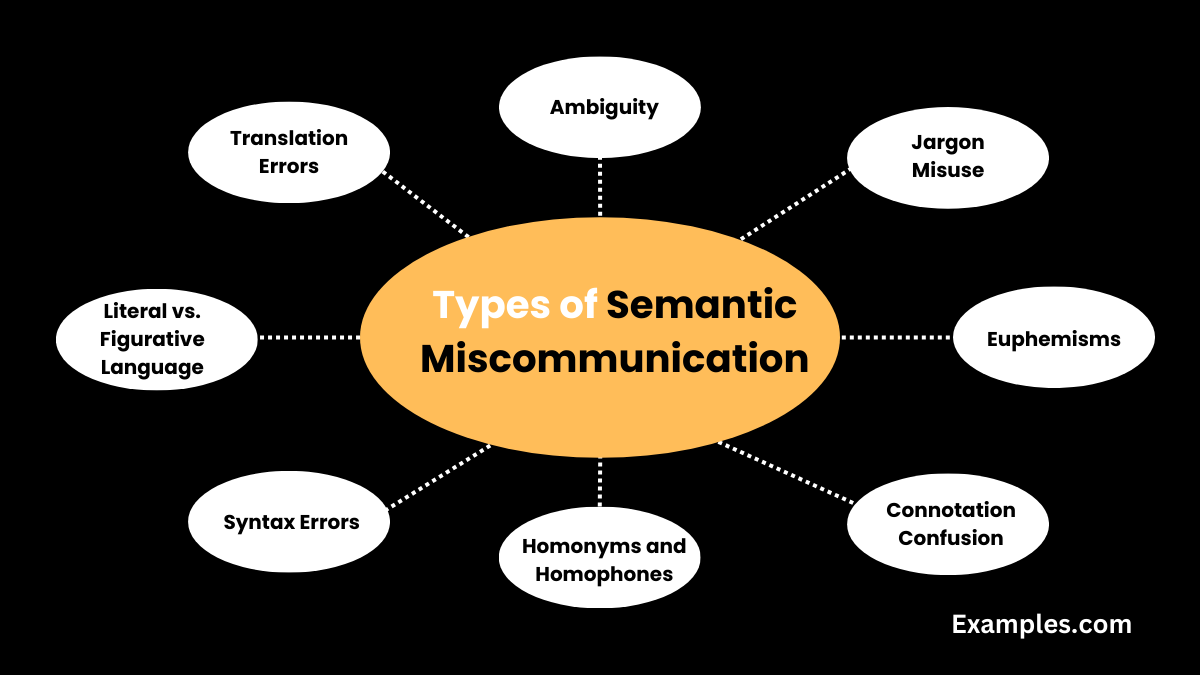19+ Semantic Miscommunication Examples
Semantic Miscommunication often occurs when words or phrases are misunderstood or misinterpreted. This comprehensive guide delves into the complexities of semantic misunderstandings, providing valuable insights and practical tips for effective communication. Whether in personal relationships, the workplace, or cross-cultural interactions, understanding the nuances of semantic miscommunication is crucial for clear and effective exchanges. This guide will help you navigate the subtleties of language, ensuring your messages are received as intended and fostering more meaningful connections.
What is Semantic Miscommunication?

Semantic Miscommunication refers to misunderstandings that arise from the interpretation of words or phrases. It occurs when the sender’s intended meaning differs from what the receiver understands, often leading to confusion or conflict. This guide explores how semantic nuances can impact communication and how to navigate them effectively.
What is the Best Example of Semantic Miscommunication?

A classic example is in business emails, where a simple phrase like “as soon as possible” can be interpreted differently, causing delays or frustration. Understanding and clarifying such phrases can greatly reduce semantic miscommunication.
20 Examples of Semantic Miscommunication
Semantic miscommunication occurs when the meaning of a message is misunderstood or interpreted differently due to language nuances, word choice, or cultural differences. This can lead to confusion, errors, and sometimes humorous outcomes. In today’s globalized world, understanding and avoiding semantic miscommunication is crucial in both personal and professional contexts. Here are 20 unique examples, each explained with example sentences to illustrate how such misunderstandings can happen and how to communicate more effectively.
- “I’m fine” in different cultures: In some cultures, “I’m fine” can mean the person is actually okay, while in others, it implies something is wrong.
- Example: “When I said I’m fine, I actually meant I was upset. It’s important to express feelings clearly to avoid misunderstandings.”
- Using technical jargon with non-experts: Misunderstandings when using industry-specific language with someone outside that field.
- Example: “Please explain this in layman’s terms; I’m not familiar with these technical phrases.”
- “Break a leg” idiom misunderstanding: Taking the phrase literally instead of understanding it as a wish of good luck.
- Example: “When I said ‘break a leg’, I was wishing you good luck for your performance, not literally!”
- Misinterpreting regional slang: Phrases common in one region can be misunderstood in another.
- Example: “In our region, ‘bless your heart’ can be a subtle way of expressing sympathy or, sometimes, disguised criticism.”
- “Thumbs up” gesture misinterpretation: This gesture is positive in some cultures but offensive in others.
- Example: “Remember, in some cultures, a thumbs up can be seen as rude. It’s always good to be aware of these differences.”
- Confusion over homonyms: Words that sound the same but have different meanings causing misunderstandings.
- Example: “When I mentioned the ‘bass’ in the music, I was referring to the low tones, not the fish!”
- Differing meanings of “quite”: In some places, “quite good” means very good, while in others, it implies mediocrity.
- Example: “I meant ‘quite good’ as in really good, not just average!”
- Misunderstanding colloquial expressions: Common phrases in one language can be confusing when directly translated.
- Example: “The phrase ‘it’s raining cats and dogs’ means it’s raining heavily, not literally animals falling!”
- Vague expressions leading to confusion: Phrases like “in a minute” can be interpreted as an exact or indefinite time.
- Example: “When I said ‘in a minute’, I meant shortly, not exactly one minute.”
- Misinterpreting formal vs. informal language: Confusion between casual and formal tones can alter perceived meaning.
- Example: “My formal email was just a polite request, not an urgent demand.”
- “Let’s have dinner sometime” ambiguity: This can be perceived as a polite, non-committal comment or a real invitation.
- Example: “I meant ‘let’s have dinner sometime’ as a genuine invitation. Let’s set a date!”
- Confusing “literally” and “figuratively”: Misuse of ‘literally’ can lead to exaggerated interpretations.
- Example: “When I said I was ‘literally dying of laughter’, I meant I found it extremely funny, not that I was in actual danger.”
- Translation nuances in different languages: Direct translations can miss the nuances of the original phrase.
- Example: “The translation missed the joke’s playfulness, making it sound more serious than intended.”
- “No problem” perceived as dismissive: In some contexts, “no problem” can be seen as an informal brush-off.
- Example: “When I said ‘no problem’, I meant it was genuinely okay, not that I was disregarding your concern.”
- Misinterpretation of sarcasm: Sarcasm can be difficult to convey and understand, especially in writing.
- Example: “I was being sarcastic in my message, which I realize now might not have come across clearly.”
- Cultural phrases losing meaning in translation: Phrases deeply rooted in one culture can lose significance when translated.
- Example: “This phrase is a cultural reference that might not hold the same meaning in a different cultural context.”
- Contrasting definitions of punctuality: Time-related terms like ‘on time’ can vary greatly between cultures.
- Example: “In my culture, ‘on time’ means exactly at the appointed hour, not a range.”
- Age-related terms varying by culture: Terms like ‘youth’ and ‘elderly’ have different age connotations in different societies.
- Example: “What we consider ‘youth’ in our culture might be different from yours, affecting our discussion’s context.”
- Different interpretations of “biweekly”: Confusion over whether it means twice a week or every two weeks.
- Example: “To clarify, by ‘biweekly’, I mean every other week, not twice within a week.”
- Varying meanings of “first floor” globally: In some countries, the first floor is the ground level, while in others, it’s the level above.
- Example: “Just to be clear, in our country, the ‘first floor’ is what you might call the second floor.
What is Semantic Miscommunication in Real Life?
- Definition and Context: Semantic miscommunication occurs when there’s a mismatch between the sender’s intended meaning and the receiver’s interpretation of words or phrases.
- Everyday Conversations: Often seen in daily interactions, where subtle nuances in language lead to misunderstandings.
- Cultural Differences: It’s prevalent across different cultures, where the same words may have varied connotations.
- Workplace Communication: In professional settings, jargon or technical terms can be interpreted differently, leading to confusion.
- Digital Communication: Especially common in texts and emails, where lack of non-verbal cues can lead to misinterpretation of tone or intent.
How to Overcome in Semantic Miscommunication
- Clear Language Use: Avoid jargon and complex language, especially when communicating with someone from a different background.
- Contextual Clarification: Provide context to your messages to avoid ambiguity.
- Active Listening: Engage in active listening to ensure understanding of the other party’s perspective.
- Feedback Loops: Encourage feedback to confirm that your message has been understood as intended.
- Cultural Sensitivity: Be aware of cultural differences in language use and interpretation.
Semantic Miscommunication at Workplace
- Role of Jargon: Misuse or overuse of industry-specific jargon can lead to miscommunication among team members.
- Email Communication: Emails often lack tone, which can lead to misinterpretation of the sender’s intent.
- Cross-Departmental Communication: Different departments may have different terminologies, leading to confusion.
- Global Teams: Diverse global teams might face challenges due to varying linguistic and cultural backgrounds.
- Feedback and Meetings: Regular feedback and clear, concise meetings can help mitigate semantic miscommunication.
Types of Semantic Miscommunication

- Ambiguity: Unclear or vague language leading to misunderstandings.
- Jargon Misuse: Specialized terms used incorrectly or out of context.
- Euphemisms: Softening language that obscures the true meaning.
- Connotation Confusion: Misinterpretation of the emotional or cultural context of words.
- Homonyms and Homophones: Words that sound alike or are spelled similarly but have different meanings.
- Syntax Errors: Incorrect sentence structure affecting meaning.
- Literal vs. Figurative Language: Misinterpreting metaphors, idioms, or expressions.
- Translation Errors: Meaning lost or altered in the process of translating between languages.
Semantic Miscommunication & Skills for Using Language Well
- Clarity and Precision: Use specific and unambiguous terms.
- Context Awareness: Understand the cultural and situational context of language.
- Active Listening: Pay close attention to the speaker’s words and intentions.
- Feedback for Understanding: Regularly check for comprehension.
- Language Adaptation: Adjust language according to the audience’s familiarity with the subject.
Causes of Semantic Miscommunication
- Cultural Differences: Varied meanings of words across cultures.
- Personal Interpretations: Individual biases and experiences affecting understanding.
- Language Complexity: Complex or technical language leading to confusion.
- Assumptions: Assuming knowledge or context not shared by others.
- Distractions and Noise: External factors that impede clear communication.
The art of avoiding semantic miscommunication is essential in our diverse and interconnected world. This guide has explored various examples and provided practical tips for effective communication. By understanding language nuances, word choices, and cultural differences, we can bridge gaps, foster clearer communication, and build stronger connections in both personal and professional interactions.



